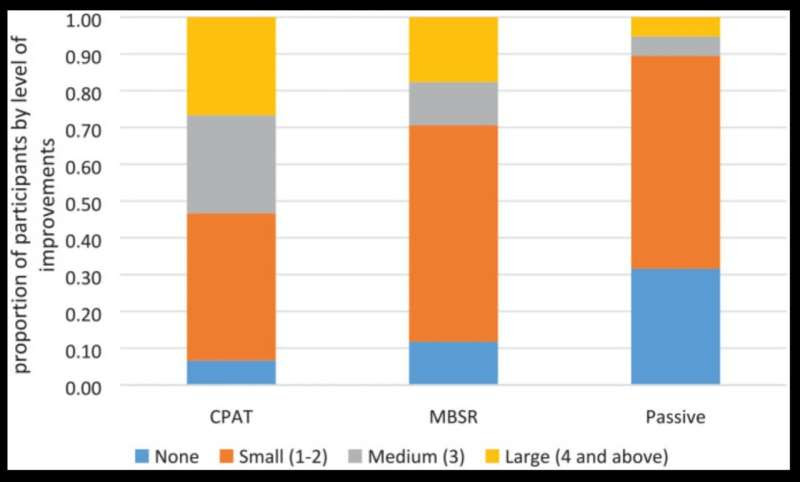by Tel-Aviv University

The proportion of the different levels of Overall Improvement Index (OII) by group.The blue bar represents proportion of participants with no improvement, the orangebar represents proportion of participants with improvements in one to two outcomemeasures, the gray bar represents proportion of participants with improvements inthree outcome measures and the dark yellow bar represents proportion of participantswith improvement in at least four outcome measures.
Computerized Progressive Attention Training (CPAT), a new treatment developed at Tel Aviv University, significantly improved the symptoms of 33 percent of students suffering from Attention Deficit Hyperactivity Disorder (ADHD). This is in comparison to an improvement in symptoms of only 11 percent of the students who participated in a parallel protocol of mindfulness training, during which the participants practiced a meditation designed to reduce their attention difficulties.
Furthermore, unlike drug treatment (such as Ritalin), these improvements were maintained even four months after the end of the treatment protocol.
The study was the doctoral dissertation of Dr. Pnina Stern, under the guidance of Prof. Lilach Shalev-Mevorach of Tel Aviv University’s Constantiner School of Education. The encouraging results of the study were recently accepted for publication in the Journal of Attention Disorders.
Prof. Shalev-Mevorach explains, “We developed the CPAT system years ago, and it did produce good results in previous studies that we conducted, mainly in children. Furthermore, in the only study that we conducted in adults with ADHD, positive findings were obtained, but without indications of ‘far transfer,’ meaning an improvement in functions for which participants were not directly trained in the treatment.”
Prof. Shalev-Mevorach points out that, in general, a scientific assertion based on far-transfer in a non-pharmacological intervention poses a great challenge for researchers, as there is no “non-pharmacological placebo” to compare to—that is, in the protocol of a non-pharmacological intervention, it is very difficult to separate the content of the intervention from environmental factors such as the attention the participants receive during the training sessions, the effort they invest in participating in the research, and so on.
In the current study, the team of researchers tried to resolve this by employing a research design that included two control groups: a regular control group, which performed the various assessment tasks at two points in time without any intervention as part of the research (the passive control group) and a second control group that participated in mindfulness training sessions under the guidance of a professional instructor. This type of training has yielded positive results in previous studies in people with ADHD.
For the experiment, 54 male and female students were recruited from Tel Aviv University and other academic institutions who have been diagnosed with ADHD. The subjects were blindly divided into three equal groups: a control group, a mindfulness group and a CPAT group.
Participants in the CPAT and the Mindfulness groups came to group meetings on the university campus once a week for two-hour sessions, where the CPAT group received Computerized Progressive Attention Training and the mindfulness group received training from a certified mindfulness instructor.
Before and after the intervention protocol, the participants of the three groups performed a comprehensive series of assessment tests: standard computerized tests to assess attention functions, behavioral assessment questionnaires (self-reported ADHD symptoms), and mindfulness questionnaires (self-reported feelings such as stress, anxiety and well-being).
In addition, a novel measurement was used for this intervention study, whose participants were, as mentioned, higher-education students: they were asked to read a text from a scientific article while their eye movements were tracked by an eye-tracker. The indices produced using the eye-tracking system made it possible to identify a pattern of inattentive reading, which was used as a measure of reading efficiency in an academic context. Finally, the participants filled out a questionnaire regarding their academic difficulties.
“The results were very positive,” says Prof. Shalev-Mevorach. “We saw improvements in the attention functions themselves, that is, ‘near transfer,’ for example in sustained attention, the ability to remain attentive for a long period of time, and in attention control, the ability to delay a routine response. But the main thing is that we saw significant improvements in the participants’ daily and academic functioning, such as reduced repeated reading while reading a scientific article.”
“Furthermore, the improvements in these attention functions were connected to the reduction in behavioral symptoms of ADHD and in repetitive reading. In other words, the CPAT trained the attention mechanisms themselves, and their improvement was related to the improvement achieved in behavioral symptoms and reading patterns.”
“33 percent of the participants who received the CPAT protocol showed a significant improvement in ADHD symptoms, compared to only 11 percent of those who underwent the mindfulness protocol. The improvements obtained were preserved in the the testing that was carried out about four months after the end of the intervention protocol.”
Prof. Shalev-Mevorach concludes, “The effects of stimulant drugs (psychostimulants) such as Ritalin and Concerta are ‘on-off.’ Studies show that patients who take Ritalin on a daily basis enjoy significant improvements, but when they stop the treatment, the improvements fade and they return to the starting point.”
“Our motivation is to bring about a profound change in basic attention functions, a change that will be significant in the long term, as an additional option alongside medication, and of course as an alternative to drug treatment in cases in which it isn’t applicable.”

Leave a Reply